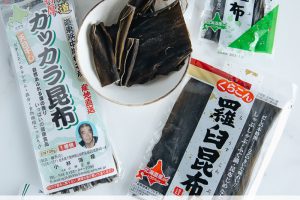Kombu is a kelp seaweed and the cornerstone of Japanese cuisine, including dashi (Japanese soup stock), sushi rice, and hot pot. Not only it’s full of umami, this nutritional power house is also rich in nutrients and minerals. In this article, we’ll explore the different uses of kombu and how you can use it in your cooking.
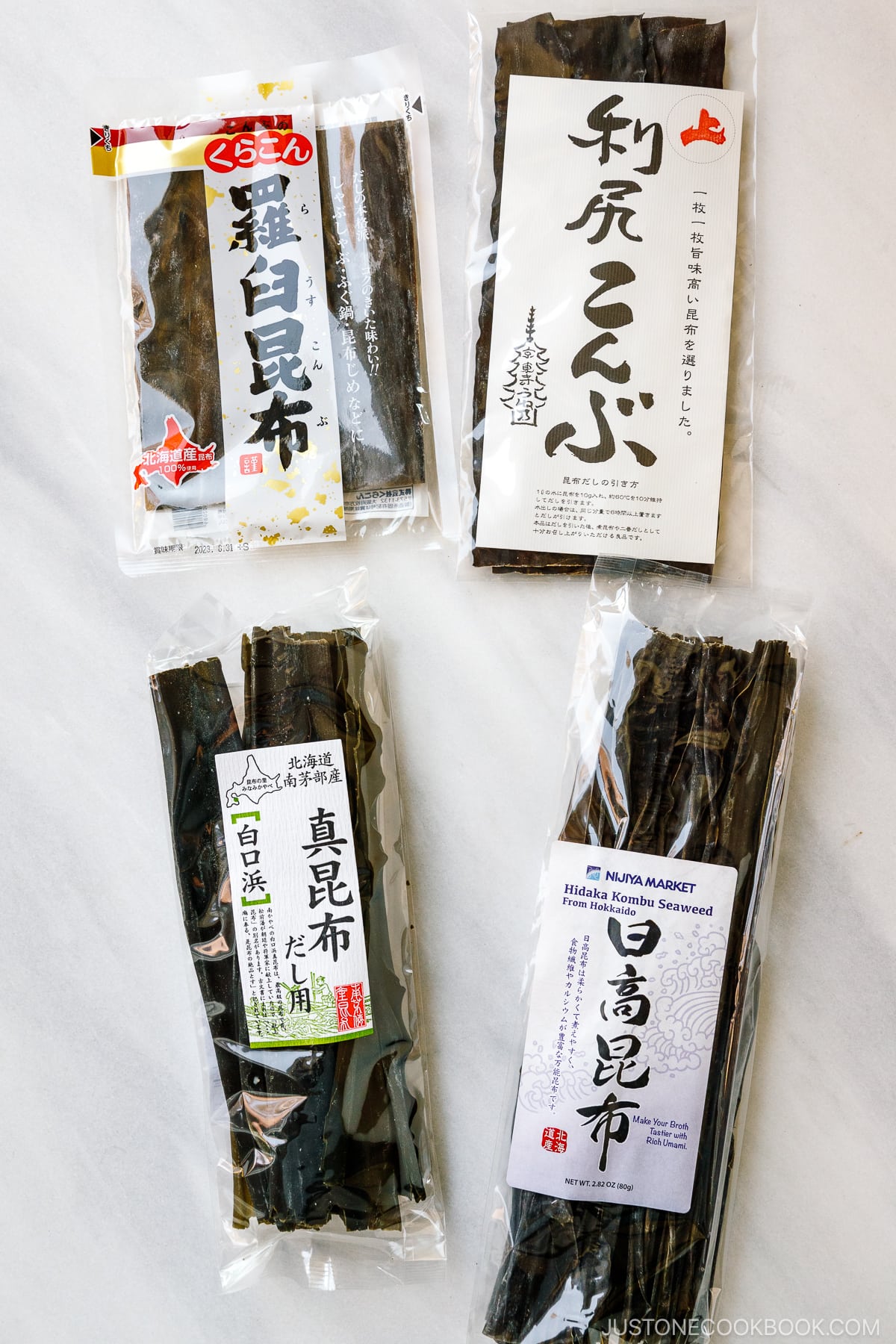
Kombu (昆布) is an edible seaweed widely consumed in East Asia. Known for its excellent source of glutamate, an amino acid responsible for umami, this sea vegetable plays an indispensable role in Japanese cuisine.
Today, beyond being a natural food enhancer, kombu has been getting a lot of attention for its many abilities, which include its nutritional benefits and as a surprisingly sustainable food source.
Table of contents
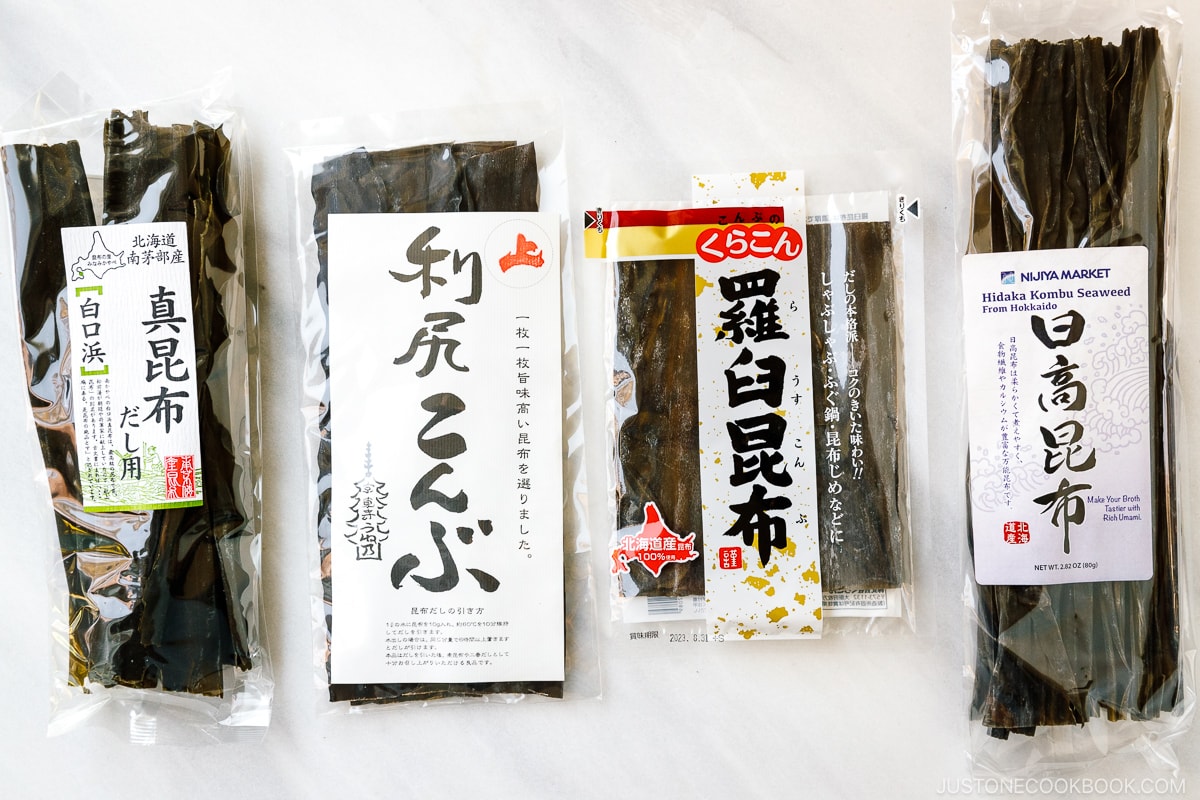
What Is Kombu
Kombu—also called kelp, haidai and dashima—is a thick flat seaweed belonging to the brown algae family. The Japanese use kombu by steeping it in water to extract the natural umami essence to make dashi (Japanese soup stock), the foundation of many Japanese dishes.
Hokkaido cultivates almost 95% of Japanese kombu in Japan as the sea kelp thrives in the cold northern waters. Most are farm-raised in nurseries where the top leaves are cut off to regrow the root. The leaves are laid out on the rocks to dry, then compressed to release the remaining moisture. Some varieties are further dried indoors to mature.
Seaweed Farming in the U.S.
In recent years, many fishermen, scientists, and consumers in the west, particularly in the U.S., see kelp and kelp farming as a solution to environmental sustainability. Once an exotic ingredient to the Americans, it has been accepted as a promising source of food, jobs, and a solution to clean ocean waters.
Kombu farming is spreading across New England, the Pacific Northwest, and Alaska (the most significant producer).
To watch: CBS 60 Minutes reports on seaweed farming and its surprising benefits
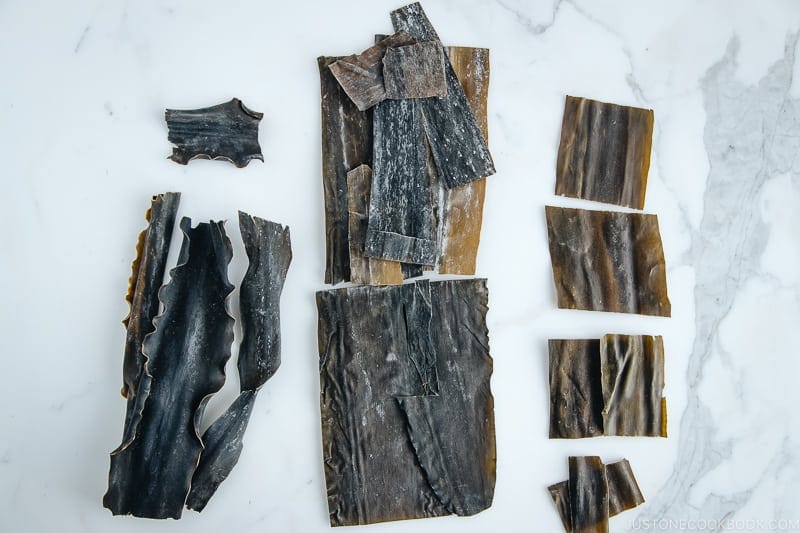
What Does Kombu Taste Like
It has a very mild, slightly briny delicate taste. Thanks to its high concentration of glutamic acids, you can use it as a natural flavor enhancer to boost umami of your dishes. You don’t have to worry that it will alter much of your food’s taste.
The white powdery substance you find on the dried kelp is a natural occurrence and it’s where much of the flavor is from, so don’t worry about washing it off.
Types of Japanese Kombu
There are many different types, each with slightly different flavors and textures. Ideally, you would use a specific variety for its characteristics.
Here’s a quick rundown:
- Ma Kombu (真昆布) – thick and wide
- Rishiri Kombu (利尻昆布) – thin and very hard
- Hidaka Kombu (日高昆布) – greenish blackish color
- Rausu Kombu (羅臼昆布) – thin and really wide
1. Ma Kombu 真昆布
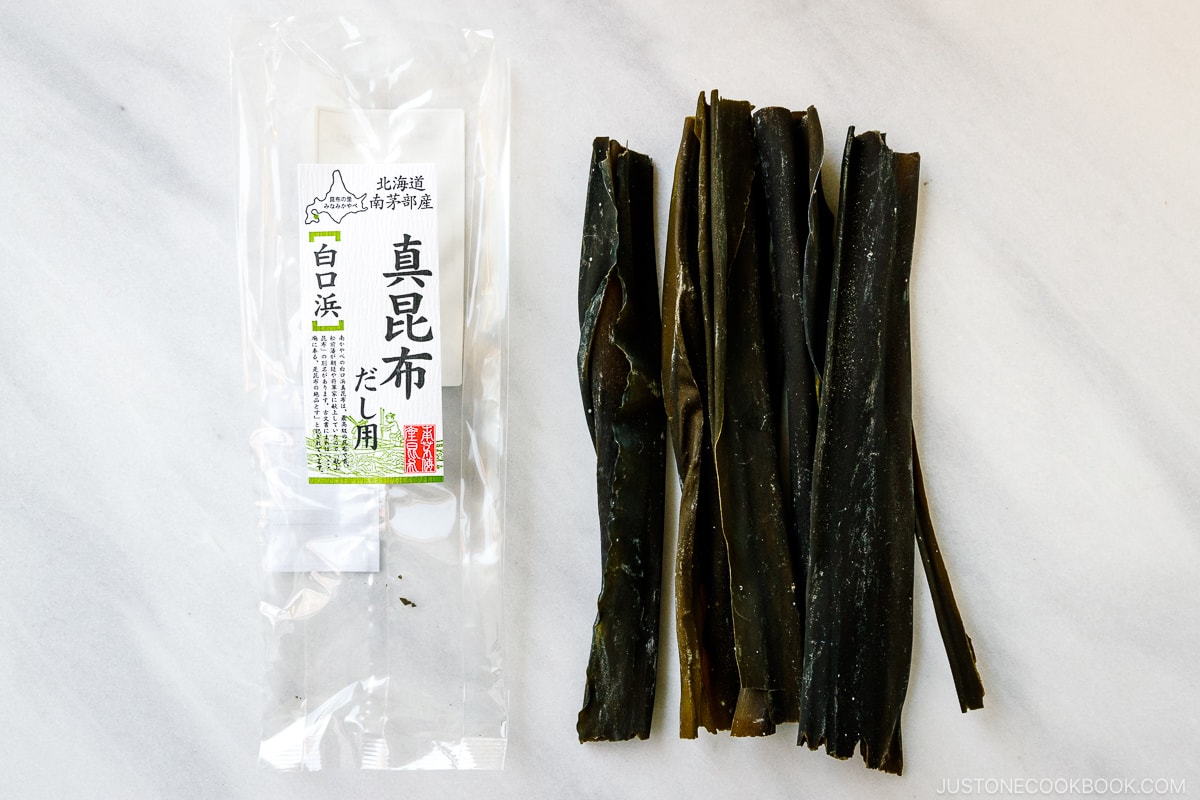
Characteristics: It’s light brown with a thick and wide wedge shape. It’s used in the Osaka area and is the most popular type.
Broth Taste: Refined, sweet, and clear broth
Suggestions: Dashi, clear soup, simmered dishes, hot pot dishes, tsukudani, shio kombu, and tororo kombu.
2. Rishiri Kombu 利尻昆布
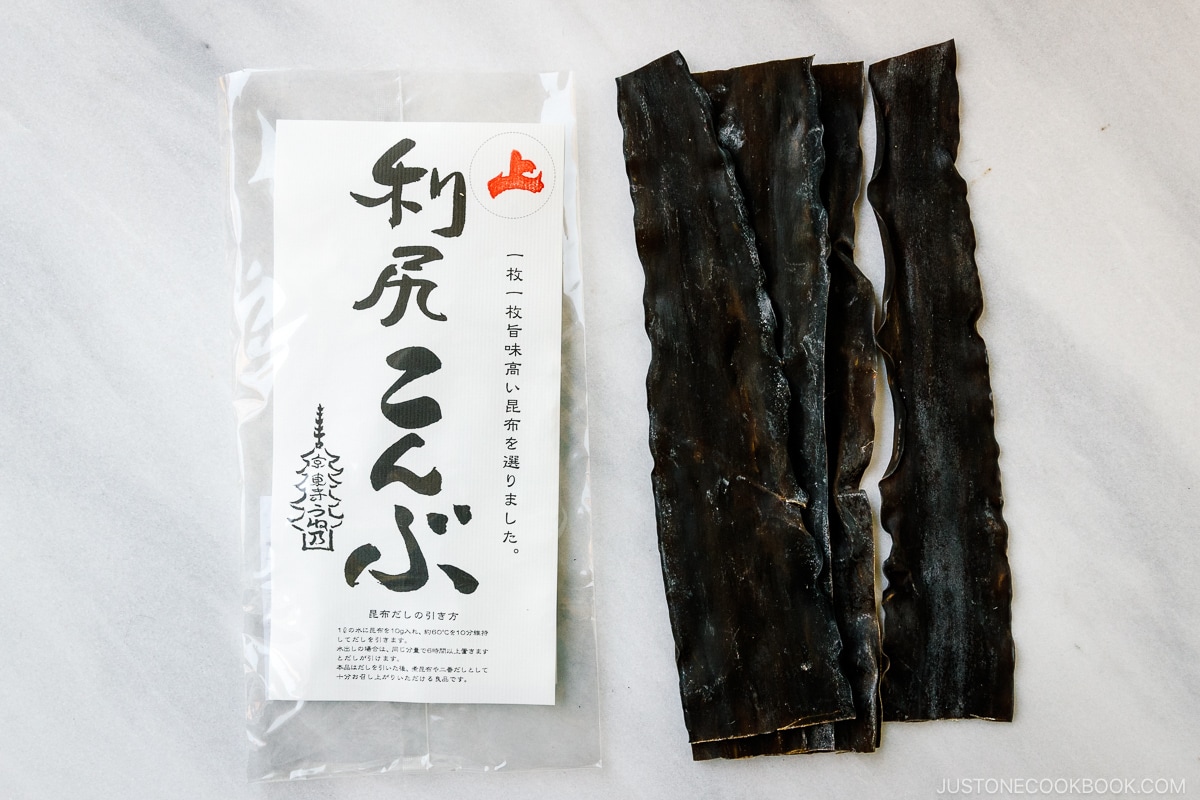
Characteristics: Narrower and harder than Ma Kombu, the base of the leaf is a thin wedge. More or less ruffled on the margins. The color is dark brown, which also imparts a dark color to the broth. It is cultivated off the coasts of Rishiri island (far northwest of Hokkaido).
Broth Taste: Strong, aromatic, a little salty, and clear broth.
Suggestions: Great for dashi and soups, including Hot Tofu (Yudofu) and pickling vegetables such as senmaizuke.
3. Hidaka Kombu 日高昆布
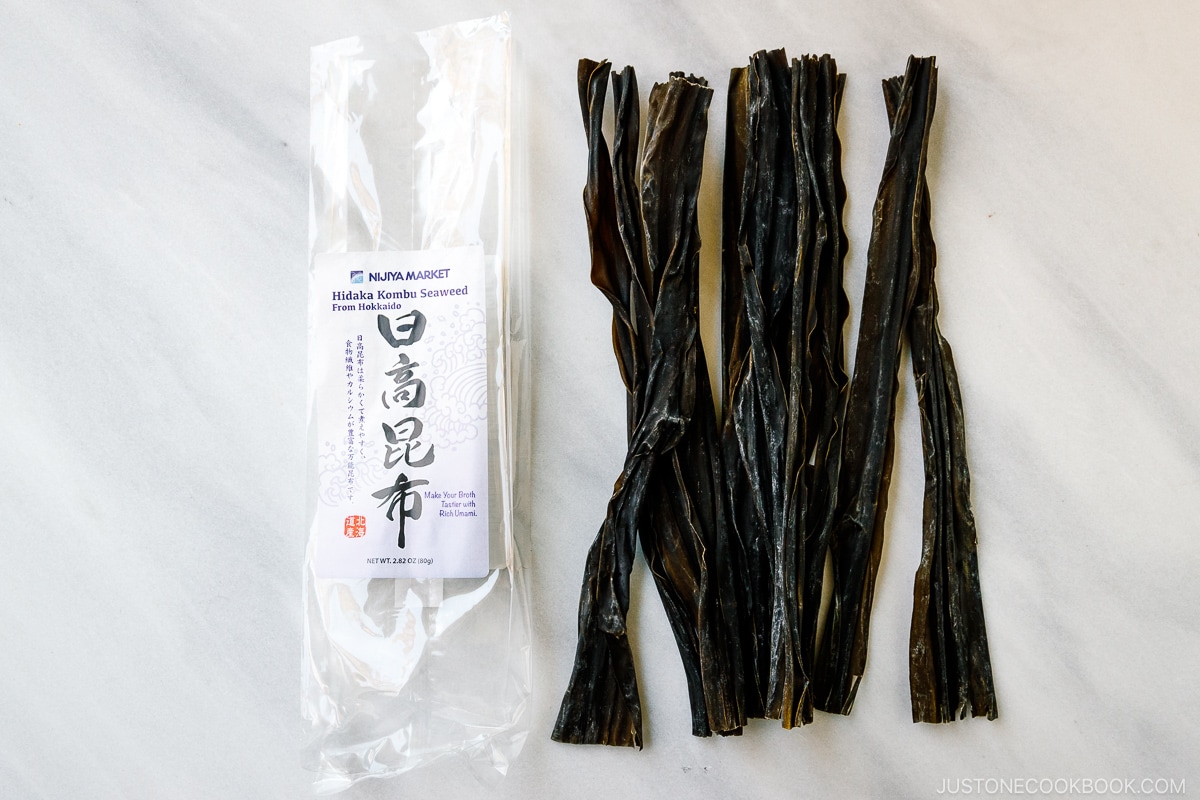
Characteristics: Dark greenish and blackish color. It is tender and easy to cook once rehydrated and, thus, also eaten in various dishes. Slightly more affordable in price. It is widely used in Tokyo and northern Japan.
Broth Taste: Slightly sweeter than rishiri kombu
Suitable Dishes: Dashi, simmered dishes (nimono), Oden (Fish Cake Stew), non-clear soups, and kombu rolls like Salmon Kombu Rolls.
4. Rausu Kombu 羅臼昆布
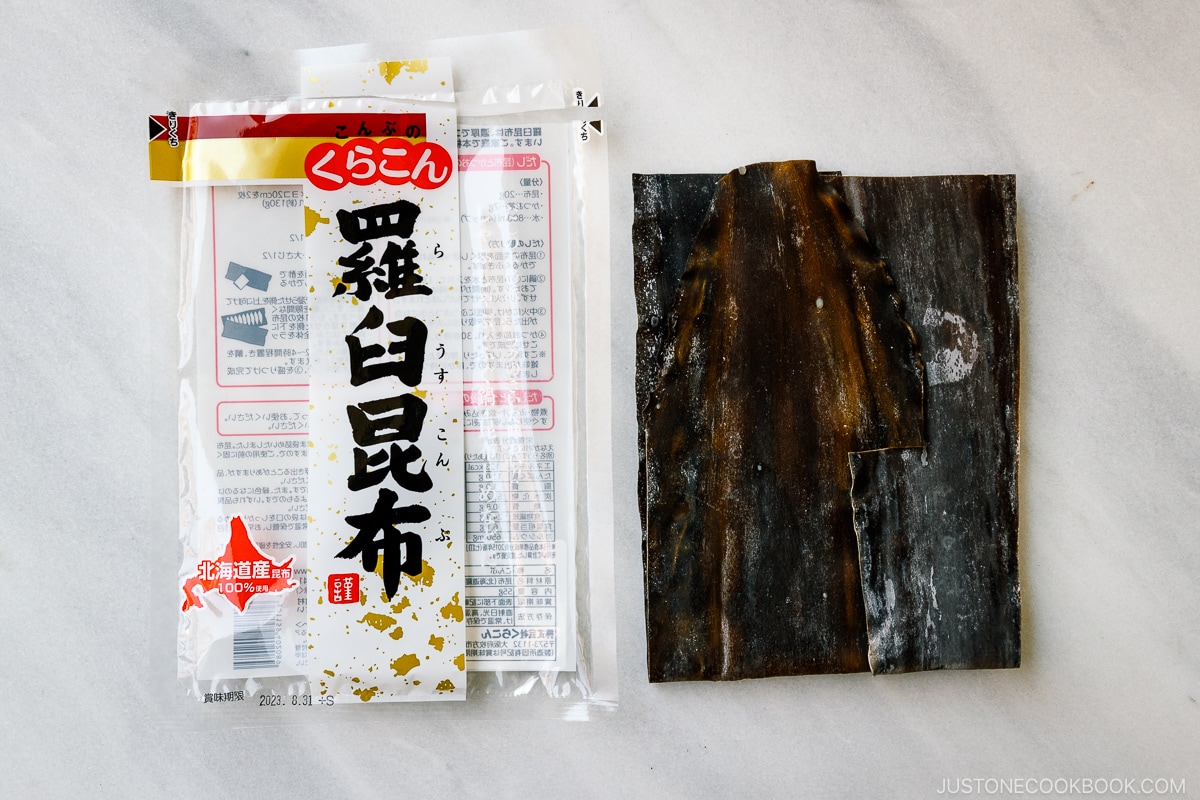
Characteristics: A thin and wide variety that hails from the town of Rausu. It’s also used in kobujime (昆布締め), a technique that preserves raw fish or vegetables between kombu sheets and to make tea. It’s called “the king of (kombu) dashi.”
Broth Taste: Rich, soft, fragrant, yellowish, and thick broth.
Suitable Dishes: Great for dashi, simmered dishes (nimono), hot pot dishes, non-clear soups, and Mentsuyu.
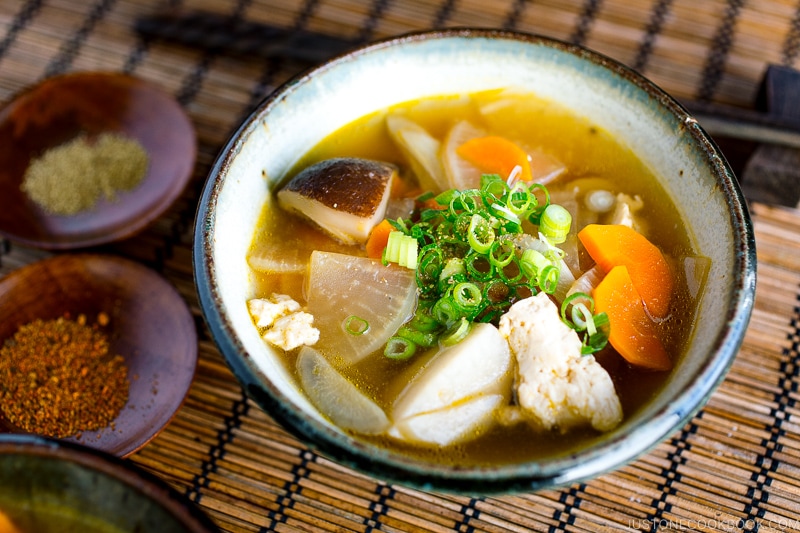
How to Use Kombu
Popular Uses of Kombu in Japanese Cuisine
- To make dashi (Japanese soup stock): The primary usage is to make the Japanese soup stock called Kombu Dashi, which is the base of miso soup, noodle soup, and many other dishes. To make kombu dashi, you reconstitute pieces by soaking or heating them gently in water (do not boil).
- To make the best sushi rice. It enhances the aroma and lends umami to the rice—the best-kept secret in making sushi rice. Get my sushi rice recipe here!
- To flavor pickles, add small strips to make this easy yet delicious pickle for an additional umami flavor.
- Use in salads. Place it in a pot, cover with water, and simmer for an hour or until soft. Cut into strips and add to salads.
- To cure fish or vegetables (konbujime): Kobujime is an ancient Japanese technique of preserving raw fish or vegetables by curing them between layers of kombu sheets. It infuses the fish or vegetables with natural umami flavor and helps absorb some liquids. You may encounter kobujime of white or oily fish like mackerel at sushi restaurants.
- Use as a garnish for soups, noodles, or rice bowls. Tororo Kombu is the thin shavings of kombu. It’s rich in flavor and can be eaten with rice balls, as a garnish to Hiroshima-style Okonomiyaki, soba, or udon.
Kombu Uses Beyond Japanese Cooking
- To cook and soften beans – Cooking beans with kombu has been a popular method as the enzymes help soften beans and make them more digestible and less gas-producing.
- To make vegetarian soup stock – It makes the quickest vegetarian soup broth or soup base for all sorts of vegetarian cooking.
- Cook with rice, millet, quinoa, rolled oats, etc. – Just like cooking kombu with beans, some people also like to add a strip to cook with different types of grain to enhance the flavor.
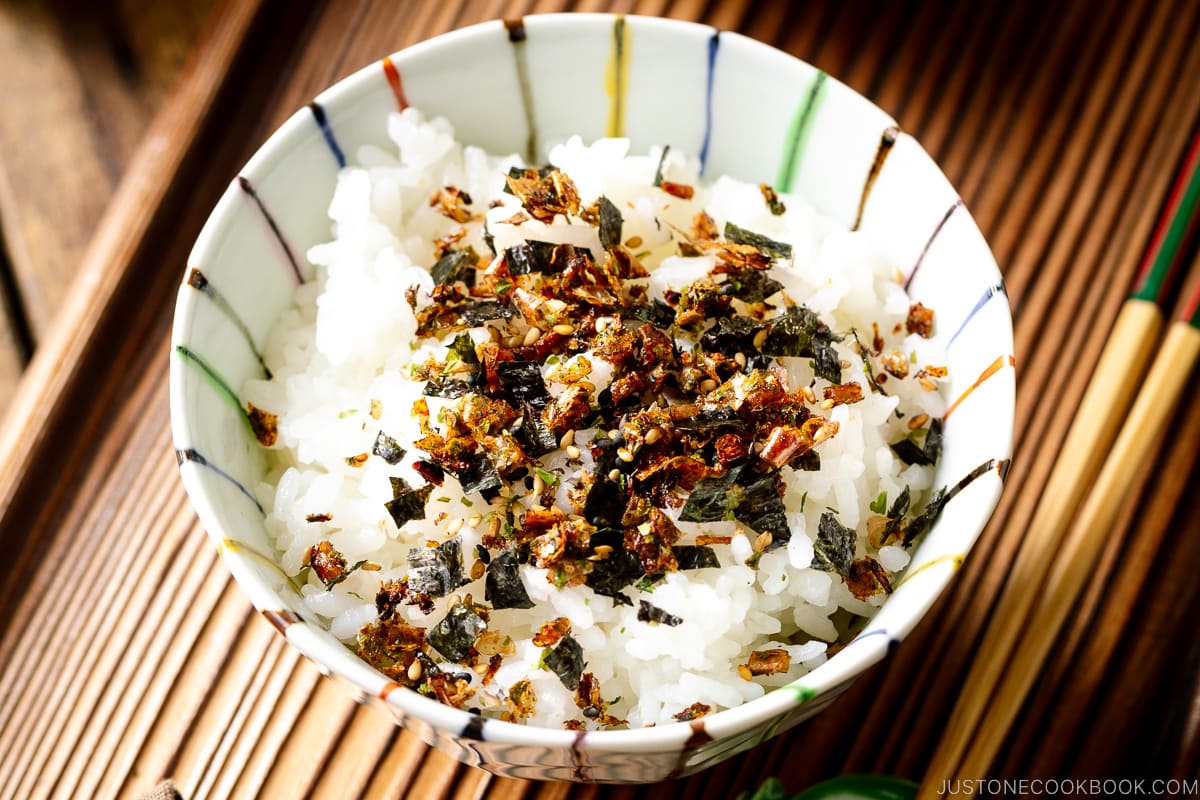
What to do with Leftover Kombu?
Wondering what you can do with the leftover strips after making dashi or soup? You can save them to make these side dishes!
- Furikake – A traditional rice seasoning.
- Tsukudani – A traditional Japanese rice accompaniment. Cut leftovers into thin strips and then simmer it with soy sauce-based sauce until cooked.
Recipes Using Kombu

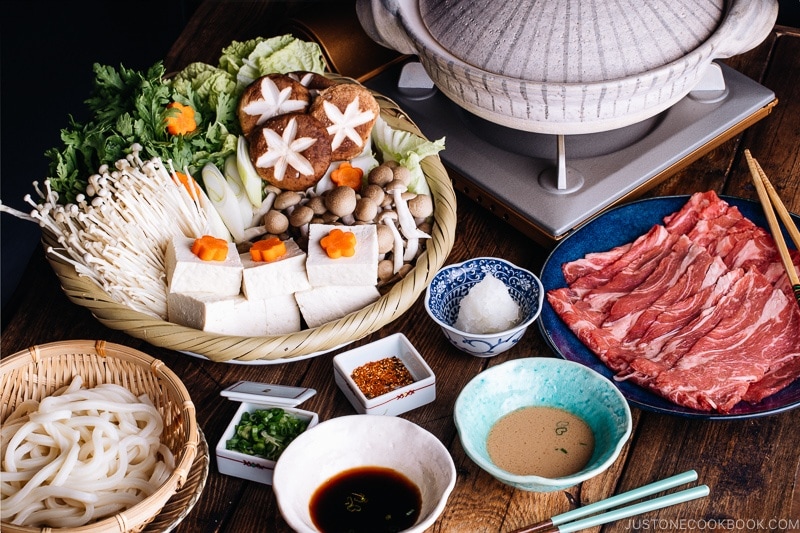
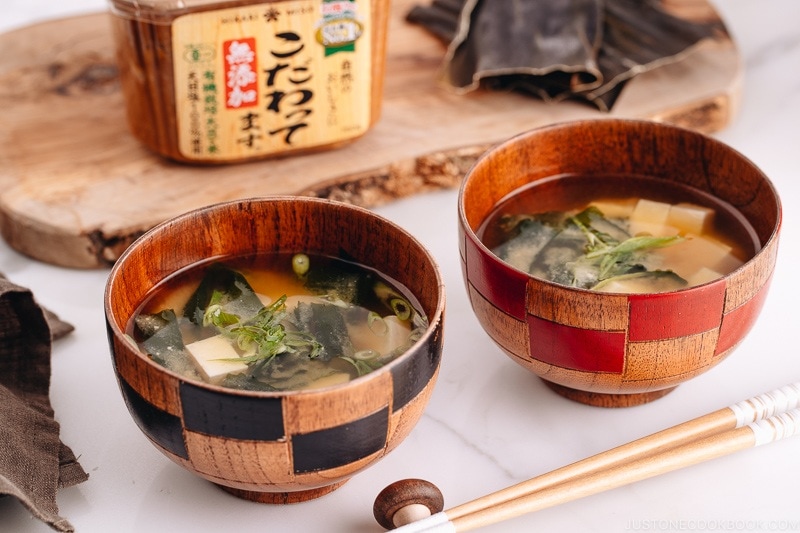
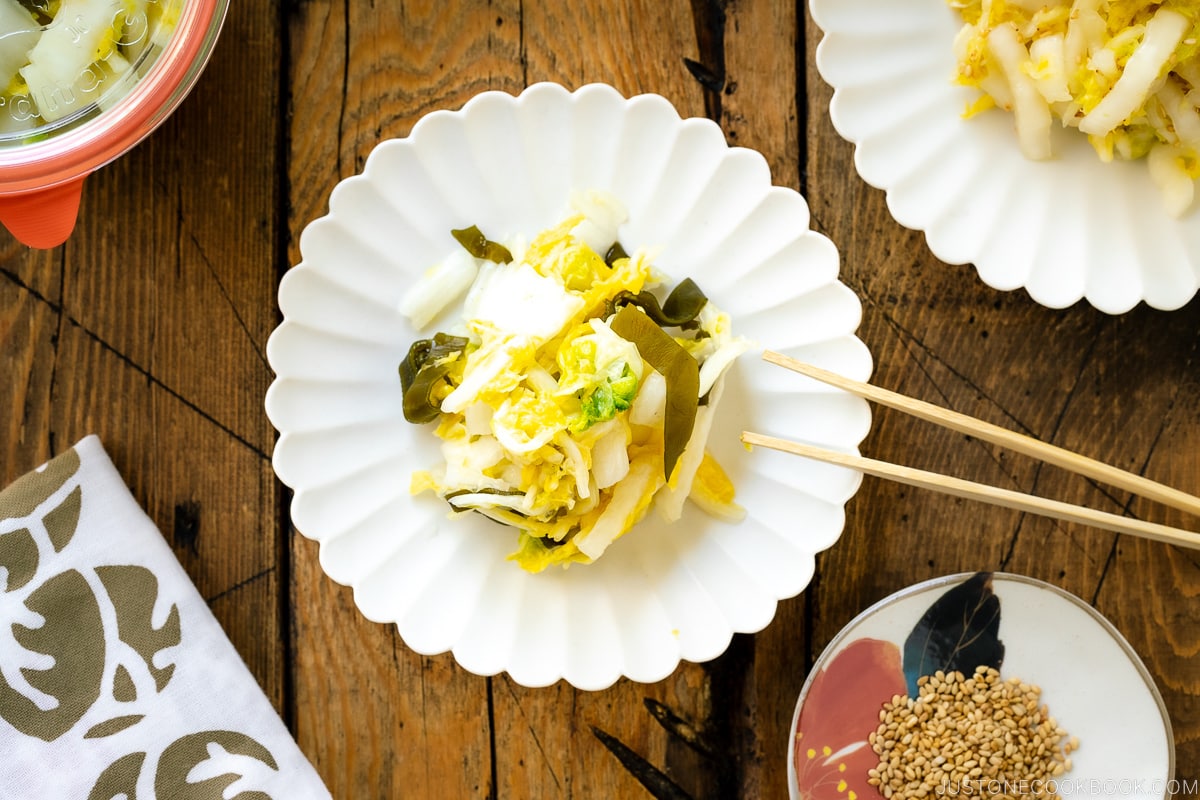
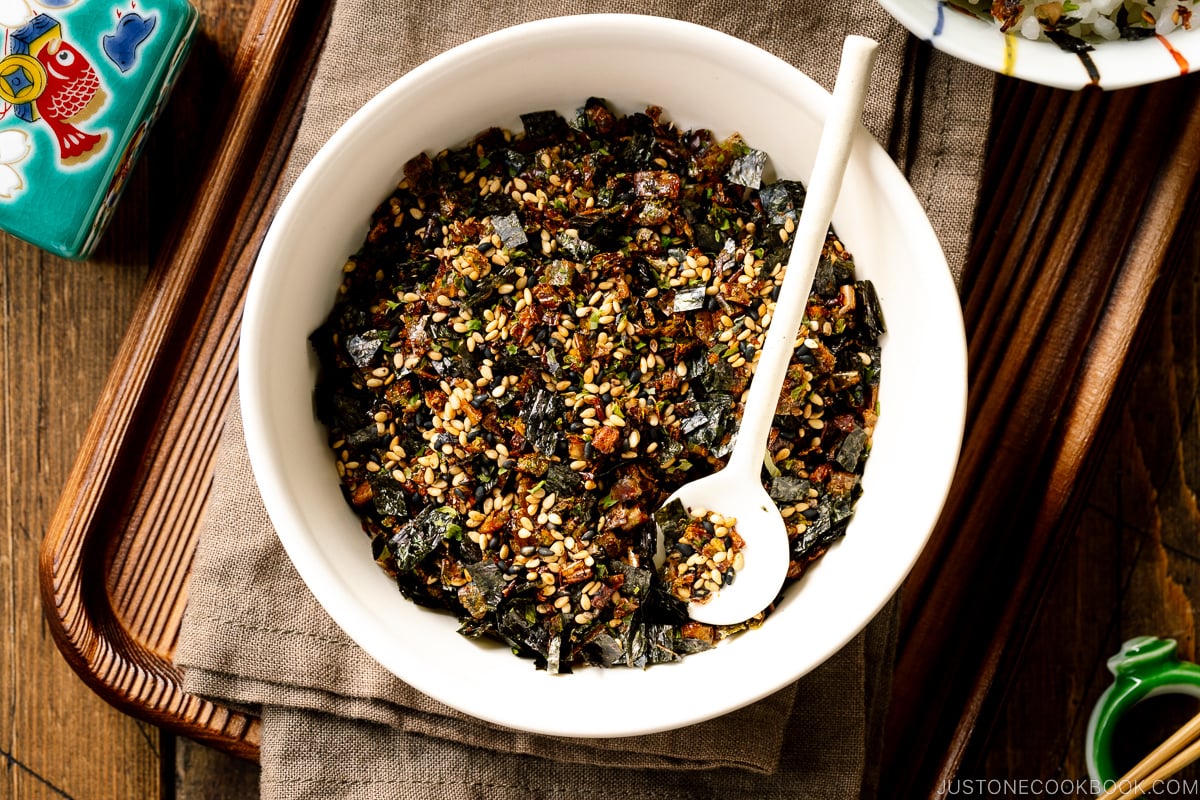
Where to Buy
You can find imported Japanese kombu in bags at Japanese and Asian grocery stores. Whole Foods, gourmet markets, and natural food stores also carry it in the Asian food aisle. The common brand would be the Maine Coast Wild Atlantic Kombu. Alternatively, you can buy good quality from here that ships internationally.
A reader Jessica recommended this Atlantic Holdfast Seaweed Company in Maine that sells different types of seaweeds.
How to Choose the Best
As mentioned above, the Japanese differentiate its use for various dishes. If you use it daily, it may make sense to buy large bags. Smaller bags with short strips may be convenient if you don’t use it frequently.
Buy kombu imported from Japan and check the expiration date. Even though it’s dried food, it can go bad if it’s not shipped correctly, so check that the bag hasn’t been damaged.

How to Store
It’s sensitive to heat, direct sunlight, and humidity. Store opened bags in an airtight or ziplock bag (I use this OXO container). Keeping it in a dry, cool, dark place is essential. You can keep it for a year. If you have older kombu, check to see if they are any mold growth. If it looks and smells fine, you can use it as long as it’s less than two years old.
Health Benefits
As well as being the best source of glutamate, it also contains high levels of iodine, essential in a wide range of bodily functions, including metabolism, bone health, and immune response. It is also a great source of dietary fiber and contains several enzymes that can break down complex sugars in the stomach that are usually indigestible.
It’s also rich in minerals and vitamins such as calcium, iron, magnesium, potassium, vitamins A and C, and copper and zinc trace minerals.
Kombu for Vegetarian & Vegan Cooking
As it joins the rank of a superfood, many vegetarians and vegans are starting to incorporate it kelp and other seaweeds in their cooking.
To learn more about the surprising health benefits, read Discover Seaweed: The Essential Ingredient of the Japanese Diet.
Note: You might see a Prop 65 warning label on the kombu product. It doesn’t cause cancer specifically; however, seaweeds (kombu, nori, hijiki) grown in Japan are harvested in water containing high traces of heavy metals than seaweeds harvested elsewhere. All kombu contain traces of organic arsenic, but not in harmful quantities, unless you consume more than the usual amount daily. In California, companies must label a Prop 65 warning on their products.
Bonus: Kobucha (Kombucha) 昆布茶
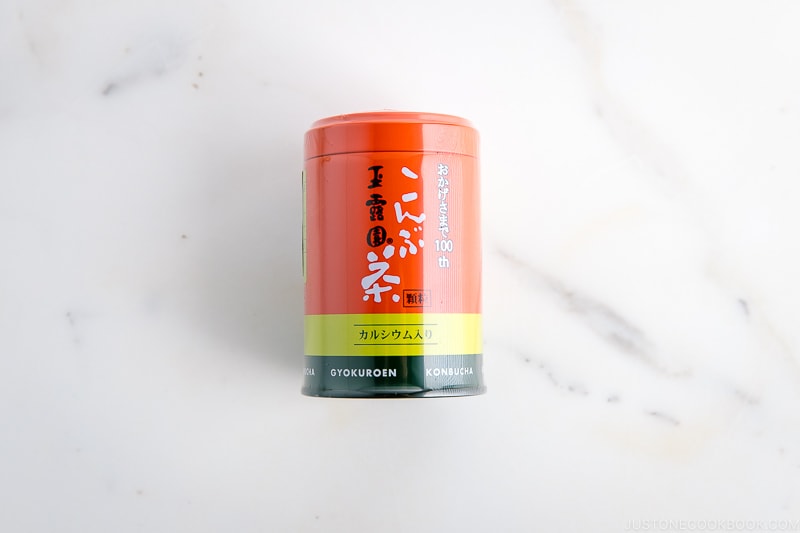
Kombucha or kobucha (昆布茶, “kombu tea”) is dried and powdered kombu. Not only can you dissolve the granules in hot water for tea, but I also use this in Unagi Chazuke and many other recipes.
Wish to learn more about Japanese cooking? Sign up for our free newsletter to receive cooking tips & recipe updates! And stay in touch with me on Facebook, Pinterest, YouTube, and Instagram.










